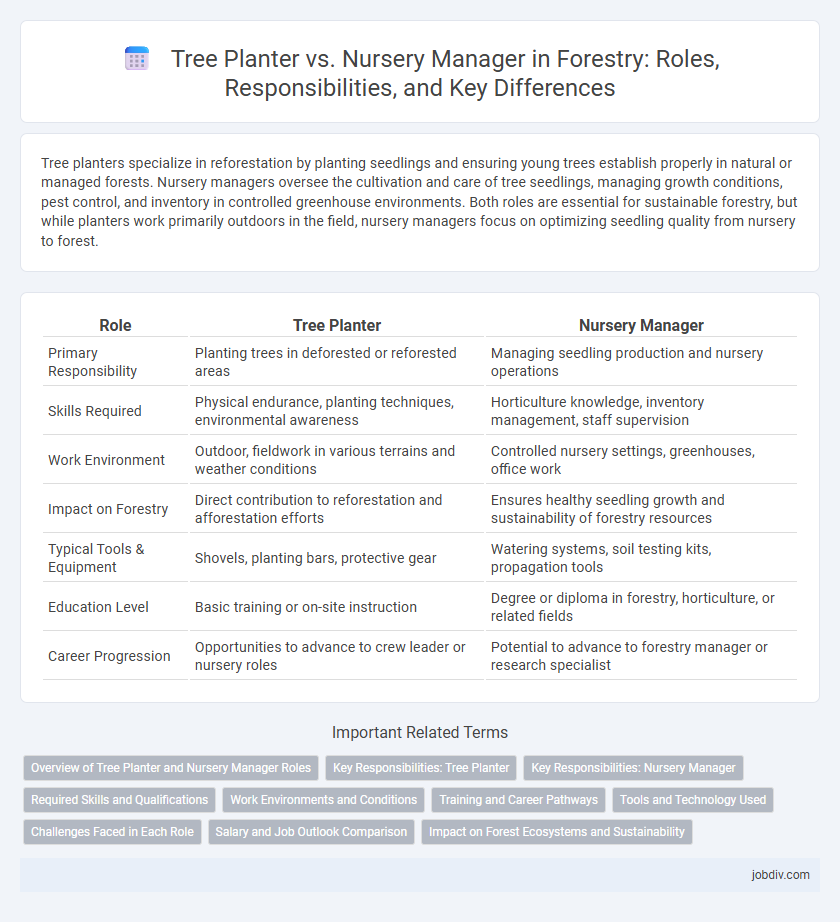Tree planters specialize in reforestation by planting seedlings and ensuring young trees establish properly in natural or managed forests. Nursery managers oversee the cultivation and care of tree seedlings, managing growth conditions, pest control, and inventory in controlled greenhouse environments. Both roles are essential for sustainable forestry, but while planters work primarily outdoors in the field, nursery managers focus on optimizing seedling quality from nursery to forest.
Table of Comparison
| Role | Tree Planter | Nursery Manager |
|---|---|---|
| Primary Responsibility | Planting trees in deforested or reforested areas | Managing seedling production and nursery operations |
| Skills Required | Physical endurance, planting techniques, environmental awareness | Horticulture knowledge, inventory management, staff supervision |
| Work Environment | Outdoor, fieldwork in various terrains and weather conditions | Controlled nursery settings, greenhouses, office work |
| Impact on Forestry | Direct contribution to reforestation and afforestation efforts | Ensures healthy seedling growth and sustainability of forestry resources |
| Typical Tools & Equipment | Shovels, planting bars, protective gear | Watering systems, soil testing kits, propagation tools |
| Education Level | Basic training or on-site instruction | Degree or diploma in forestry, horticulture, or related fields |
| Career Progression | Opportunities to advance to crew leader or nursery roles | Potential to advance to forestry manager or research specialist |
Overview of Tree Planter and Nursery Manager Roles
Tree planters are responsible for planting and nurturing young trees in reforestation projects, which requires physical endurance and knowledge of soil conditions and tree species. Nursery managers oversee the propagation and care of tree seedlings, managing irrigation, pest control, and staff to ensure healthy growth. Both roles are critical in forestry operations, with tree planters focusing on fieldwork and nursery managers emphasizing cultivation and operational management.
Key Responsibilities: Tree Planter
Tree planters are responsible for the efficient and accurate planting of tree seedlings to support reforestation and afforestation efforts, requiring knowledge of soil conditions and species-specific planting techniques. They ensure proper seedling handling, spacing, and depth to maximize survival rates and contribute to sustainable forest management. Physical endurance and adherence to safety protocols during outdoor labor-intensive tasks are crucial for successful tree planting operations.
Key Responsibilities: Nursery Manager
Nursery Managers oversee the propagation and cultivation of seedlings, ensuring optimal growth conditions through soil management, irrigation, and pest control. They coordinate inventory management, maintain equipment, and supervise a team of workers responsible for planting, nurturing, and harvesting plants. Their role includes strategic planning for production schedules aligned with reforestation or landscaping projects, ensuring high-quality stock for sustainable forestry initiatives.
Required Skills and Qualifications
Tree planters require physical endurance, knowledge of planting techniques, and the ability to work in diverse outdoor environments, often needing a high school diploma and basic training. Nursery managers need expertise in horticulture, plant propagation, pest management, and often possess a degree in forestry, agriculture, or environmental science along with strong leadership and business skills. Both roles demand a commitment to sustainable forestry practices but differ significantly in their technical knowledge and managerial responsibilities.
Work Environments and Conditions
Tree planters primarily work outdoors, often in remote and rugged forested areas, facing physically demanding conditions such as variable weather and uneven terrain. Nursery managers typically operate in controlled nursery environments where they oversee the growth of seedlings and young trees, working in greenhouses or outdoor beds with moderate exposure to environmental factors. Both roles require knowledge of forestry practices, but tree planters experience more intense physical labor and exposure to natural elements compared to nursery managers who focus on cultivation and plant health in managed settings.
Training and Career Pathways
Tree planters typically receive on-the-job training focused on planting techniques, soil assessment, and safety protocols, often starting in entry-level positions with seasonal work opportunities. Nursery managers usually hold formal education in horticulture, forestry, or environmental science, combined with experience in plant propagation, pest management, and staff supervision, advancing through roles such as nursery technician or assistant manager. Career pathways for tree planters can lead to specialized forestry roles, while nursery managers often progress toward senior management positions, research, or consultancy within the forestry and horticultural industries.
Tools and Technology Used
Tree planters primarily use handheld tools such as shovels, dibble bars, and planting spades designed for efficient seedling placement, often supplemented by GPS-enabled devices to optimize planting patterns. Nursery managers rely on advanced irrigation systems, climate control technology, and automated seed sowing machinery to ensure optimal growing conditions and maximize seedling survival rates. Both roles incorporate data management software to monitor growth metrics and resource allocation, enhancing operational efficiency in forestry production.
Challenges Faced in Each Role
Tree planters grapple with physical exhaustion, unpredictable weather conditions, and the pressure to meet high planting quotas in remote locations, which can affect both efficiency and tree survival rates. Nursery managers face challenges in maintaining optimal growing conditions, managing pests and diseases, and ensuring genetic diversity while balancing budget constraints and labor availability. Both roles require specialized knowledge and adaptability to increasingly variable environmental factors driven by climate change and regulatory demands.
Salary and Job Outlook Comparison
Tree planters typically earn an hourly wage ranging from $12 to $20, with seasonal employment affecting income stability, while nursery managers earn between $45,000 and $75,000 annually, reflecting full-time positions with greater responsibility. The job outlook for tree planters remains steady due to ongoing reforestation efforts, but opportunities are highly seasonal and physically demanding. Nursery managers face a growing demand as sustainable forestry and plant production industries expand, offering more stable career growth and higher earning potential.
Impact on Forest Ecosystems and Sustainability
Tree planters directly influence forest ecosystems by enhancing biodiversity and promoting carbon sequestration through the establishment of healthy, native tree species. Nursery managers ensure the production of resilient, high-quality seedlings that support sustainable reforestation efforts and minimize genetic bottlenecks. Both roles are critical for maintaining ecosystem balance and advancing long-term forest sustainability.
Tree Planter vs Nursery Manager Infographic

 jobdiv.com
jobdiv.com